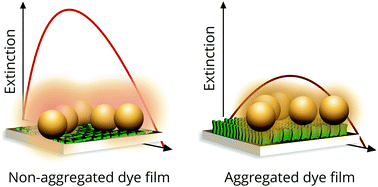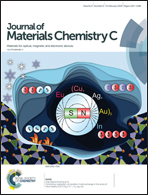Plasmon-enhanced light absorption at organic-coated interfaces: collectivity matters†
Abstract
Plasmon resonance describes a phenomenon that enhances optical absorption of visible light at solid interfaces coated with organic materials. This stronger light absorption in thin films may increase the efficiency of solar cells, photocatalysis and organic electronics. Metal nanoparticles and organic molecules have very different values of specific extinctions making it extremely difficult to control the enhancement effect and to study the mechanism of this enhancement. Herein, we report the first direct observation of plasmon enhanced absorption at the organic-coated interfaces by using self-assembled gold aggregates with a tunable structure. Precise control of the spectral properties of these aggregates makes it possible to use them as plasmonic antennas for nanometer-thick layers of organic dyes on solids. When deposited on top of the ultrathin layers of various dyes (mono- and double-decker tetra-15-crown-5-phthalocyanines and 5-carboxytetramethylrhodamine), the light-trapping enhancers with resonantly adjusted plasmon coupling can boost their absorption by more than 500% in a wide range of wavelengths (520–660 nm) and in a wavelength-selective manner. However, this plasmonic effect strongly depends on the aggregation state of the dyes in the interfacial film. Whereas plasmon enhancement of absorption occurs in non-aggregated systems, it is completely quenched at interfaces with aggregated dyes such as perylene diimide or tetrapyridyl porphyrin, which exhibit optically collective behavior. Computer modeling showed that the relative arrangement of the nanoparticles with respect to the organic dyes on the supporting solid controls the propagation of the enhanced plasmonic field and the occurrence of the plasmon enhancement effect. Our findings provide new insight into the interaction of light and complex interfaces that might allow the rational design of plasmon-enhanced optical materials.



 Please wait while we load your content...
Please wait while we load your content...